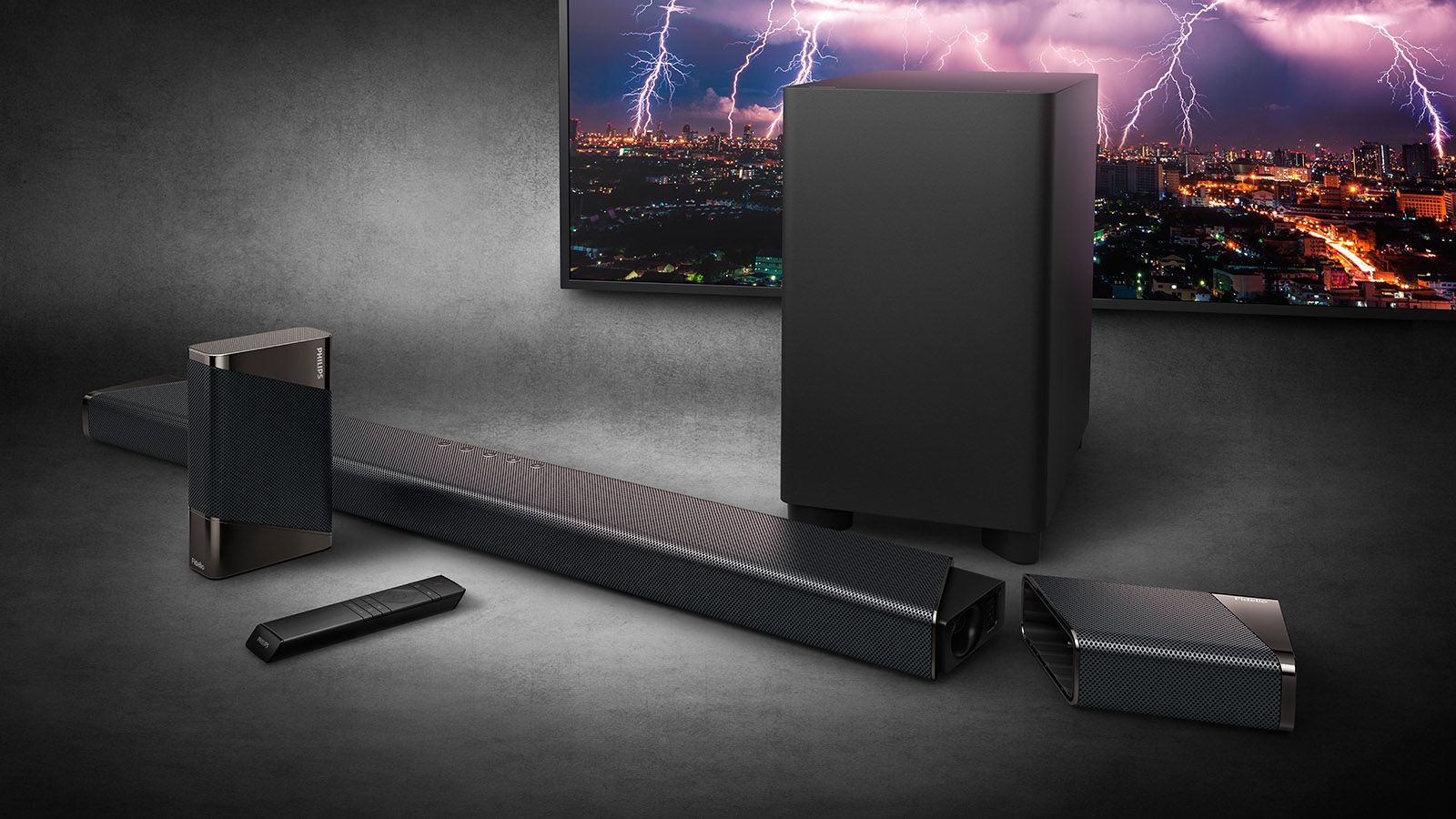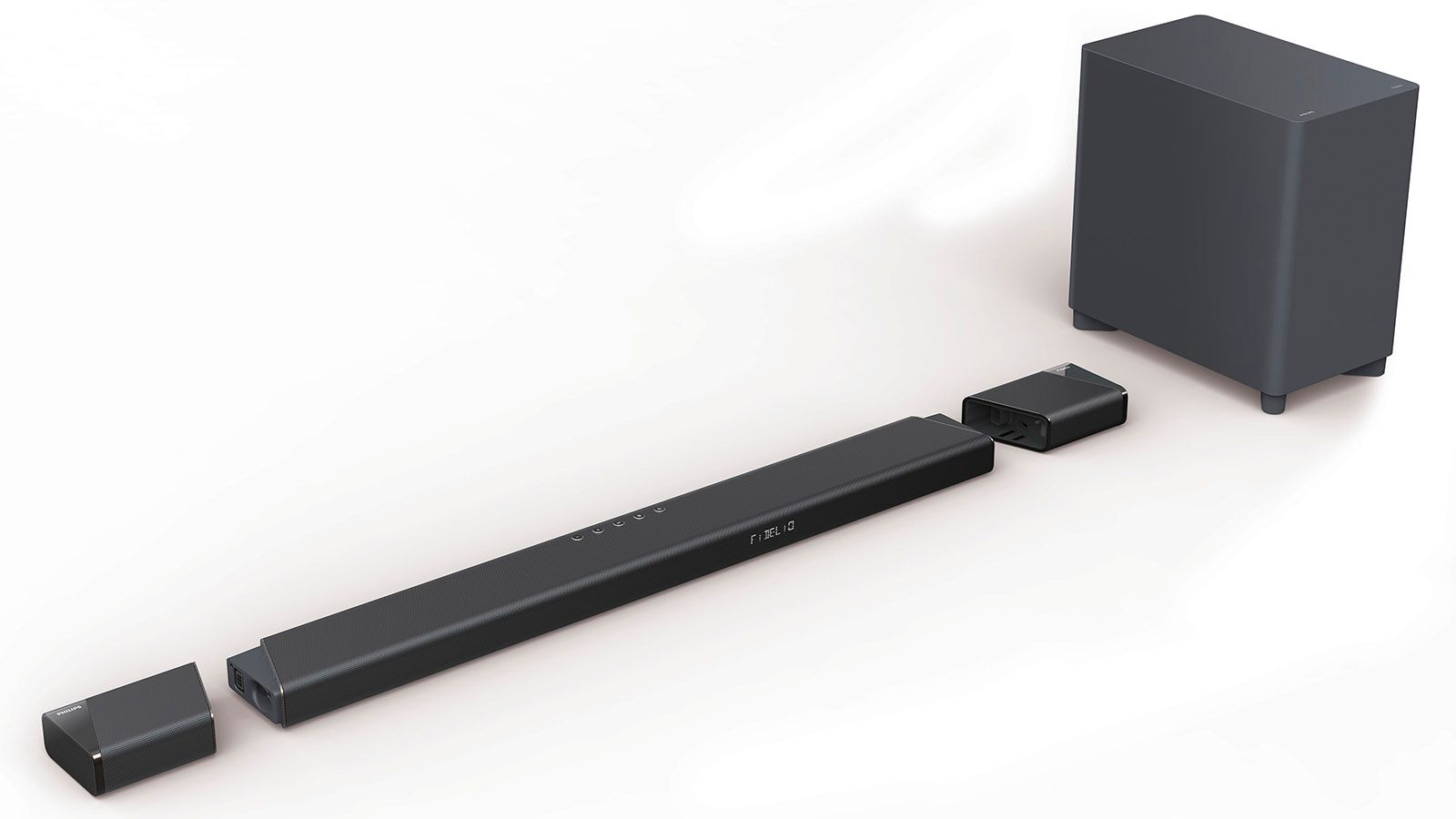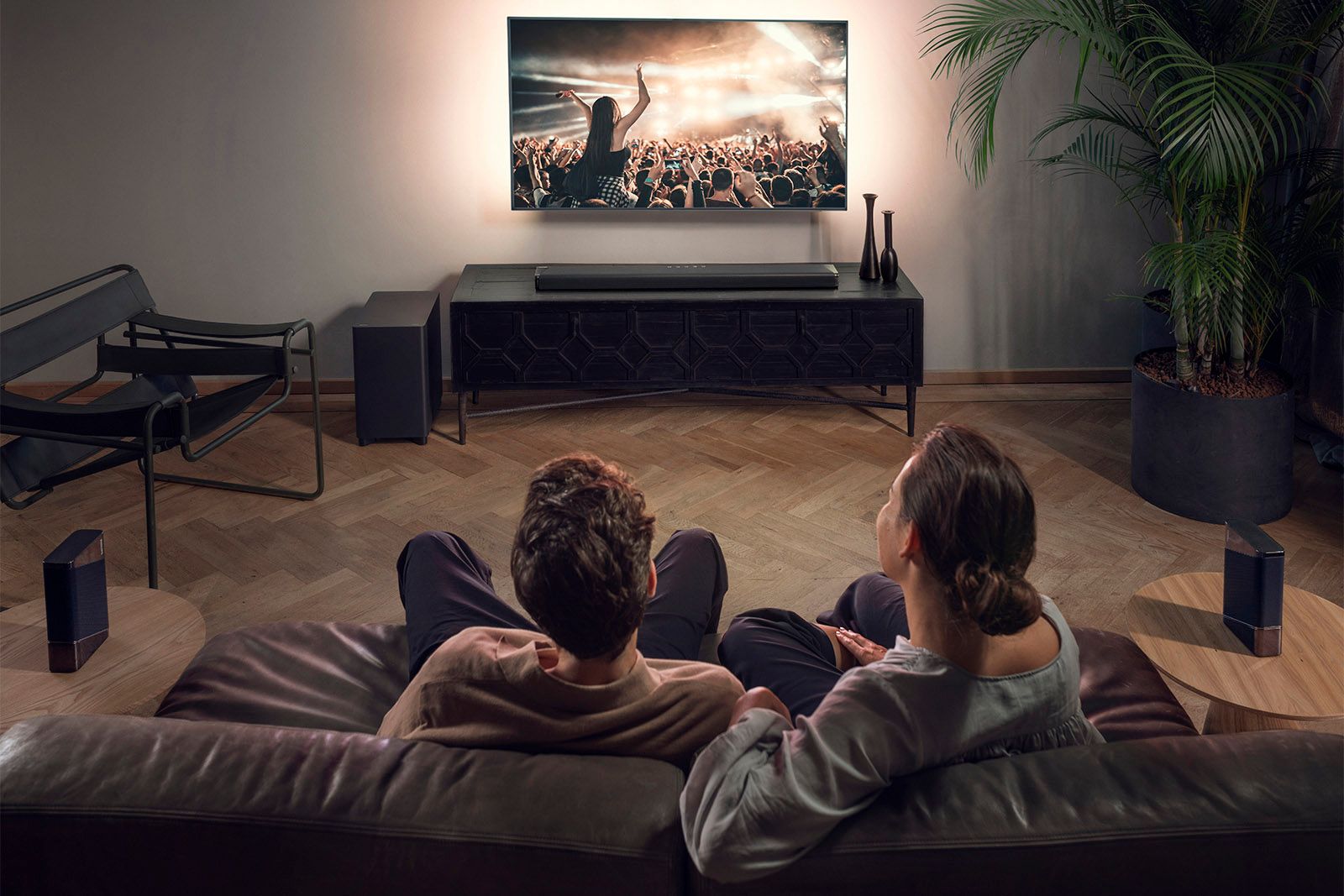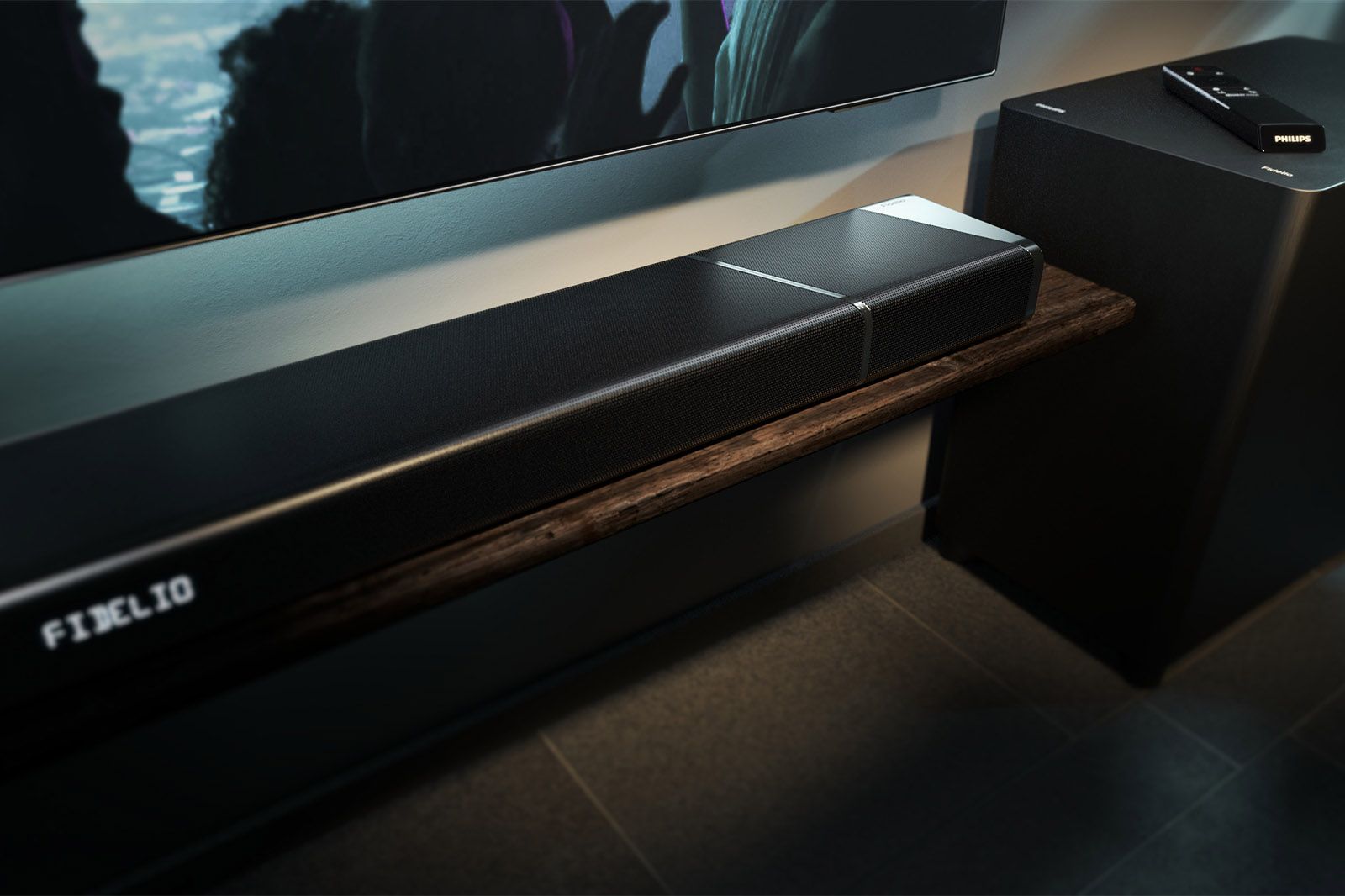The Philips Fidelio B97 is a premium cinematic soundbar compatible with Dolby Atmos and DTS:X audio sources to output object-based surround. It's also IMAX Enhanced certified and Play-Fi compatible.
The big party trick is detachable rear speaker modules. The system can be used as a standard two-piece with wireless subwoofer, or in full surround mode with the end pods relocated for wireless rear left/right duties, running on battery power, making for a 7.1.2 surround setup.
Philips dubs its detachable speaker enclosures Surround Sound on Demand, which neatly sums up what they do. Soundbar decoding automatically adjusts to match. So does this party trick make the B97 a more versatile soundbar than its competitors?
Our quick take
We rate the B97 as an entertaining cinematic soundbar. The detachable rears provide a genuinely convincing surround sound experience. The 'bar is also beautifully made and stylishly finished.
There are caveats though. Those expecting a deeply immersive Dolby Atmos listening experience may well be underwhelmed, as there's no overt height imagery. Some users may also tire of constantly popping off and then replacing these rear modules depending on the listening scenario.
Still, the mid-range performance is superb, and integration with the big subwoofer is seamless, offering arguably a best-in-class bass performance.

Philips Fidelio B97 - 4.0 / 5
| FOR | AGAINST |
|---|---|
|
|
Design
- Soundbar (w/h/d): 1312 x 55.6 x 120mm / Subwoofer: 230 x 400 x 407mm
- 3x HDMI ports, 1x Digital Optical Audio output, 1x analogue minijack input
- Wi-Fi and Bluetooth
If you're after an upmarket, stylish-looking TV sound upgrade, then the B97 should fit the bill perfectly. A solid 0.8mm fine metal mesh driver grille, purportedly tuned for better transmission of mid-to-high frequencies, provides a distinctive cover, while the end caps have a mirrored finish.
System info is conveyed via an LED text display on the front of the 'bar. There are on-body controls for volume and input selection, but most users will just point-and-click with the simplified remote control.
Connectivity comprises three HDMI ports, all of which are v2.0. There's eARC available, with support for Dolby Vision, HDR10+ and HLG high dynamic range formats. There are also digital optical audio and 3.5mm analogue line inputs. Wireless connectivity is via Bluetooth v4.2 and Wi-Fi.
It's not unusual for the wireless subwoofer in any 2.1 system to look like an afterthought - but that's not the case here. Finished in matte grey, it sports a sympathetic, rear-ported design. A large 8-inch downward firing driver is protected by four substantial feet.
The B97 is described as 7.1.2 - seven channel outputs from the soundbar, one subwoofer central bass output, and two rear channels - but this configuration is a bit of a movable feast.
The total soundbar driver count is sweet at 16, but not all are used all the time. It all depends how the B97 is configured.
A pair of full range drivers handle centre channel duties. They're joined by two pairs of 3.5-inch race-track drivers left and right, plus two full-range upfirers. Side-mounted soft-domed tweeters add width to the soundstage. The detachable rear modules feature matching full-range drivers and tweeters.
The 'bar hides a secondary set of side-mounted 19mm soft dome tweeters which come into play when the side speakers are detached. These are angled, with a horn-style wave guide which aims (literally) to reflect audio from surrounding walls to strengthen the sense of immersion.
All these various drivers sit within their own rigid, modular enclosures, made from PC ABS, a combination of polycarbonate and Acrylonitrile Butadiene Styrene (ABS).
The magnetic speaker modules de-couple with a light pull and are returned with a determined push. These rears pair with the main bar automatically over Wi-Fi. Battery life is rated upwards of 10 hours, so that should be enough for a decent binge-watching session.
Fully assembled, the B97 soundbar is 131cm. It shrinks to 100cm when the rears are detached. So the system is ideally partnered with 55- to 65-inch screens.
Features
- IMAX Enhanced
- DTS Play-Fi enabled
- Google, Alexa and Siri support
The B97 is compatible with DTS Play-Fi, an interoperable standard which enables multiroom streaming and high-res audio playback. Best thought of as a more widely supported alternative to Heos by Denon and Yamaha MusicCast, but it still only has traction with US audio brands.
Philips owner TP Vision has thrown considerable weight behind the Play-Fi standard, extending support to its TV range, but as yet it's difficult to know just how significant its inclusion here is.
The merits of IMAX Enhanced certification are similarly debatable, with precious little IMAX Enhanced certified software available. We tried the system with IMAX Enhanced Blu-ray discs and it correctly flagged the incoming audio stream. It didn't sound appreciably different to common or garden Atmos though.
Codec support extends to high-res audio and Google Assistant is on hand for voice assist. If Chromecast isn't your sandpit of choice, there's also Amazon Alexa and Siri support, with Apple Airplay 2 available for iOS users.
Performance
- Dolby Atmos and DTS: X object-based decoding
- 2.1 and multichannel listening options
The Philips B97 offers a significantly different listening experience, depending on your chosen configuration.
In full theatre mode, with rears detached, the 'bar combines a standard left, centre, right for its front arrangement, delivered by three 3.5-inch racetrack drivers, augmented by two angled 2.5-inch drivers on top for height, and single 19mm soft dome tweeters at either end of the 'bar to stress width.
The rear speaker modules use a front-mounted, single race-track driver, with edge tweeters which duplicate the drivers they normally cover when docked to the main 'bar. Popped off and placed behind, these side-mounted tweeters are no longer active.
The result is a genuine 360 degree soundstage. Sounds are steered back, forth and all around with dizzying effectiveness.
The wireless sub proves a star performer too. It's seamlessly integrated and drops deliciously deep on command. It's overall slam is grand.
But there is a caveat. For a Dolby Atmos soundbar, there's surprisingly little height in the mix, and certainly no overhanging canopy of sound. In many ways, this is a traditional front/back performer.
The system makes short work of big blockbusters. It's officially rated at 450W (888W peak), with 240W going to the wireless sub. We'd have no hesitation recommending this for larger spaces.
To recap
Detachable rear speakers ensure this soundbar offers authentic cinematic surround sound, although its Dolby Atmos object-based output lacks stature despite a plethora of drivers - but with wide wraparound audio and best-in-class bass performance, it's an all-round success.



